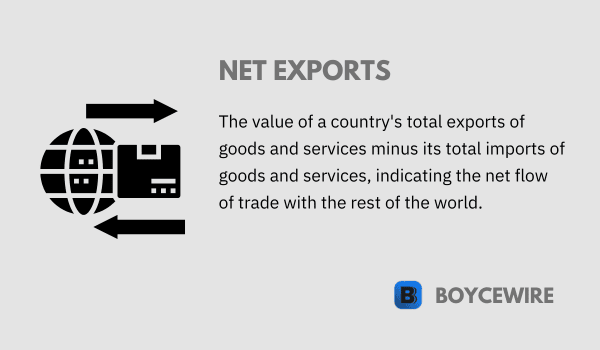Net Exports: Definition, Formula & Examples

What are Net Exports?
In the increasingly interconnected global economy, international trade plays a vital role in shaping a nation’s prosperity and development. One important aspect of international trade is net exports, which refers to the difference between the value of a country’s exports (goods and services produced domestically and sold abroad) and its imports (goods and services produced abroad and consumed domestically). As a crucial component of a nation’s Gross Domestic Product (GDP), net exports offer insights into the overall health of an economy and its competitiveness in the global market.
Key Points
- Net exports represent the difference between a country’s total exports of goods and services and its total imports of goods and services.
- Net exports are calculated by subtracting the value of imports from the value of exports. The formula is: Net Exports = Exports – Imports.
- A positive net exports value indicates a trade surplus, meaning the country is exporting more than it is importing. This can contribute to economic growth, increase in national income, and accumulation of foreign reserves.
Calculating Net Exports
Net exports can be broken down into two main components: exports and imports. Exports are goods and services produced within a country and sold to customers in other countries. They bring in foreign currency, boost domestic production, and create jobs. On the other hand, imports are goods and services produced in foreign countries and consumed domestically. Imports can provide consumers with a wider variety of products, often at lower prices, and can promote competition among domestic producers.
Calculating net exports is relatively simple: Net Exports (NX) = Exports (X) – Imports (M). If a country exports more than it imports, it has a positive value, indicating a trade surplus. Conversely, if a country imports more than it exports, it has a negative value, indicating a trade deficit.
A trade surplus can signify a competitive and productive economy that is able to sell its goods and services to the global market effectively. On the other hand, a trade deficit may indicate an economy that relies heavily on foreign goods and services, which can lead to a dependence on other countries and potential economic vulnerabilities. However, it’s important to note that having a trade surplus or deficit is not inherently good or bad; rather, it depends on the specific circumstances and economic policies of a country.
Examples of Net Exports
China
China is a prime example of a country with a significant trade surplus. Its rapid economic growth, low production costs, and efficient manufacturing capabilities have enabled it to become the world’s largest exporter of goods. As a result, China’s net exports are consistently positive, contributing significantly to its GDP growth.
United States
In contrast, the United States has been experiencing a trade deficit for several decades, as it imports more goods and services than it exports. While the U.S. is a major exporter of goods and services, its imports of consumer goods, raw materials, and technology products outweigh its exports, resulting in a negative net export value. This trade deficit has been a topic of political debate and concern for the country’s long-term economic health.
Germany
Germany is another example of a country with a trade surplus. Its strong industrial base, emphasis on high-quality manufacturing, and strategic focus on exporting have enabled it to maintain a positive net export value. Germany’s trade surplus has played a significant role in its economic stability and growth, particularly within the context of the European Union.
India
India’s net export situation has varied over time, with periods of both trade surpluses and deficits. In recent years, India’s net exports have been negative due to its increased demand for imported goods, particularly oil and gold. However, the country has been working to boost its exports through various initiatives, such as the “Make in India” campaign, aimed at promoting domestic manufacturing and increasing India’s presence in the global market.
These examples demonstrate that countries can experience different net export situations based on their economic policies, industrial capabilities, and global market conditions. It’s essential to analyze the broader context to understand the implications of a country’s trade surplus or deficit.
Factors Affecting Net Exports
Several factors can influence a country’s net exports, impacting its overall trade balance. Understanding these factors can help policymakers and businesses make informed decisions and develop strategies for enhancing their international trade performance. Some of the key factors affecting net exports include:
1. Exchange Rates
Currency exchange rates play a significant role in determining the attractiveness of a country’s exports and imports. When a country’s currency is strong, its exports become more expensive for foreign buyers, while imports become cheaper for domestic consumers. Conversely, a weak currency makes exports more competitive and imports more expensive. Fluctuations in exchange rates can have significant implications for a country’s net exports.
2. Production Costs
The cost of producing goods and services in a country directly influences its ability to compete in international markets. Low production costs can make a country’s exports more attractive to foreign buyers, leading to higher net exports. Factors such as labor costs, energy costs, and access to raw materials can impact a country’s production costs.
3. Trade Policies
Governments can implement various trade policies to influence net exports, such as tariffs, import quotas, and export subsidies. These policies can either promote or restrict international trade, affecting the trade balance. For example, protectionist policies may discourage imports and encourage domestic production, while free trade agreements can facilitate trade by reducing barriers between countries.
4. Economic Growth
The overall state of a country’s economy can impact its net exports. In times of economic growth, domestic demand for goods and services may increase, leading to higher imports and lower exports. Conversely, during an economic downturn, domestic demand may decrease, resulting in reduced imports and potentially higher net exports.
5. Consumer Preferences
Changes in consumer preferences can influence the demand for domestic and foreign goods and services. Factors such as product quality, brand reputation, and cultural preferences can play a role in shaping consumer choices, ultimately impacting a country’s net exports.
6. Global Market Conditions
The global economic environment can also have an impact. Factors such as economic growth in trading partner countries, geopolitical events, and global supply chain disruptions can influence the demand for a country’s exports and imports, affecting its trade balance.
Net Exports and GDP
Gross Domestic Product (GDP) is a widely used indicator that measures a country’s economic performance, representing the total value of all goods and services produced within its borders over a specific time period. One of the critical components of GDP calculation is net exports, which refers to the difference between a country’s total exports and imports. In the context of GDP, net exports contribute to the overall economic output and are a key determinant of a country’s economic health.
GDP can be calculated using the expenditure approach, which sums up the total spending on consumption, investments, government expenditure, and net exports:
GDP = C + I + G + (X – M)
Where:
- C represents consumption or consumer spending
- I denotes investments by businesses and households
- G stands for government spending
- X represents total exports
- M denotes total imports
In this equation, (X – M) represents net exports. A positive value implies that a country exports more than it imports, contributing positively to its GDP. On the other hand, a negative value indicates that the country imports more than it exports, which reduces its GDP.
The role of net exports in GDP highlights the importance of international trade in a country’s overall economic performance. An increase can stimulate economic growth, as it signifies higher demand for domestic goods and services in foreign markets. Conversely, a decrease can signal economic contraction, as it indicates that domestic production is insufficient to meet domestic demand, leading to a higher reliance on imported goods and services.
Furthermore, net exports can affect other GDP components, such as consumption, investments, and government spending. For instance, a higher value may result in increased business revenues and, in turn, greater investments and consumer spending. Similarly, a positive trade balance can lead to higher government revenues through taxes, facilitating increased public spending on infrastructure and social programs.
In conclusion, the performance of a country’s international trade is pivotal in shaping its GDP and overall economic well-being. Policymakers and businesses need to comprehend the influences on international trade and formulate strategies to bolster their trade performance, thereby fostering economic growth and prosperity.
Conclusion
In conclusion, the balance between a country’s exports and imports is a critical component of its economic performance. A trade surplus, indicating more exports than imports, has a positive impact on GDP, while a trade deficit, reflecting more imports than exports, has a negative impact. Policymakers and businesses need to understand the factors that influence this balance, including exchange rates, comparative advantages, trade policies, and global economic conditions.
By placing emphasis on improving the competitive edge of domestic industries, fostering innovation, and cultivating beneficial trade partnerships, countries can bolster their trade balance, stimulate economic growth, and generate positive repercussions throughout the economy. Moreover, international trade’s significance in shaping a nation’s economic well-being within a globally interconnected landscape cannot be overstated, as it intertwines with various components of GDP such as consumption, investments, and government spending.
FAQs
Net exports refer to the value of a country’s total exports minus the value of its total imports over a given period, typically a year.
Net exports can be calculated by subtracting the value of imports from the value of exports: Net Exports = Exports – Imports.
A positive net export (trade surplus) occurs when the value of a country’s exports exceeds the value of its imports. This suggests that the country is exporting more goods and services than it is importing, resulting in a net inflow of foreign currency.
A negative net export (trade deficit) occurs when the value of a country’s imports exceeds the value of its exports. This implies that the country is importing more goods and services than it is exporting, resulting in a net outflow of foreign currency.
About Paul
Paul Boyce is an economics editor with over 10 years experience in the industry. Currently working as a consultant within the financial services sector, Paul is the CEO and chief editor of BoyceWire. He has written publications for FEE, the Mises Institute, and many others.

Further Reading
 Price Ceiling: Definition, Examples & Graph - A price ceiling is a legal restriction which prevents businesses from selling beyond that price.
Price Ceiling: Definition, Examples & Graph - A price ceiling is a legal restriction which prevents businesses from selling beyond that price.  Asymmetric Information: Definition, Causes & Examples - Asymmetric information or information asymmetry is where one party in a transaction has more information than the other.
Asymmetric Information: Definition, Causes & Examples - Asymmetric information or information asymmetry is where one party in a transaction has more information than the other.  Collective Bargaining: Definition, Types & Examples - Collective bargaining is the process where a group of employees ‘collectively’ negotiate with the employer.
Collective Bargaining: Definition, Types & Examples - Collective bargaining is the process where a group of employees ‘collectively’ negotiate with the employer. 
